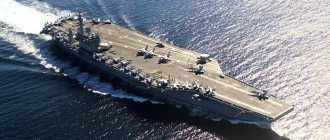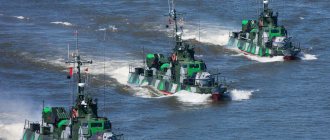The price to pay for naval dominance. Fighting career of “The Mighty Hood” (12 photos)
Author: teamwows
26 May 2022 18:17
Tags: Great Britain Navy Germany second world war history
1387
12
On May 17, 1920, the battlecruiser Hood became the flagship of the battlecruiser squadron of the British Atlantic Fleet. During the interwar period, the Mighty Hood's service was limited only to combat training missions, as well as cruise cruises, in which the ship demonstrated the power of the British fleet. In this regard, he became a favorite of the public and the press.
In 1923, he, along with the battle cruiser Repulse, accompanied by light cruisers, went on a cruise around the world. Having visited dozens of ports on the Pacific and Atlantic oceans, they traveled more than 70,000 kilometers.
0
See all photos in the gallery
"The Mighty Hood" during a circumnavigation in Australia, March 1924. In 1929, work began on modernizing the ship, which lasted two years. During the modernization, the volume of fuel tanks was increased, and a command and rangefinder post for anti-aircraft fire control systems was installed. In addition, the Hood was equipped with two eight-barreled 40-mm Pom-Pom machine guns. Torpedo tubes and torpedo ammunition received anti-fragmentation protection. Aircraft equipment has also undergone changes. As a result of subsequent modernizations, anti-aircraft weapons only became stronger. And again the war By the time the Second World War began, the Mighty Hood was in the Scottish Scapa Flow and was part of a squadron of battlecruisers. In the first months of the war, the battlecruiser provided cover for convoys and went out on patrol. At the end of November 1939, in the company of the French battleship Dunkerque (Dunkirk) and the destroyers Hood, he went on patrol in the hope of intercepting Kriegsmarine ships. However, they never had the chance to meet the enemy. In April-May 1940, the ship underwent modernization in Plymouth, during which several 140 mm guns were replaced with 102 mm twin mounts. Hood also acquired very dubious UP missile launchers. The rocket carried a landmine suspended by a parachute. The British assumed that an enemy plane, when colliding with a parachute cable, would pull the bomb towards itself and provoke detonation. In practice, this technique turned out to be ineffective, and these missile launchers were never used.
×
0
UP launcher. There were five similar installations on HMS Hood, one of which was located on the roof of the second tower. In the summer of 1940, the battlecruiser with the aircraft carrier Ark Royal, accompanied by destroyers, moved to Gibraltar. On June 25, France capitulated. The French fleet passed into the hands of the Vichy regime, and the threat of its unification with the Kriegsmarine no longer seemed fantastic to the English lords. For this reason, the Admiralty formed Force H, which included the battleships Valiant and Resolution, two light cruisers and 11 destroyers. English “Catapult” The operation to intercept French ships under the code designation “Catapult” began on July 3, 1940. Admiral Sommerville's attempts to resolve the conflict peacefully were unsuccessful. The English guns were the first to thunder. A few minutes later, the battleship Bretagne (Brittany) was blown up by Hood fire. As a result of its explosion, 997 French sailors were killed.
0
The battleship Bretagne under fire from British ships, a few minutes before the death. After the death of the Brittany, the Hood's guns turned towards the battleship Dunkerque. Just six months ago they hunted German raiders together. The first Hood shell to hit the Dunkirk hit the charging tray of the eighth gun, after which a small fire started. The second projectile passed through the seaplane hangar, simultaneously breaking the electrical cables of the steering gear. These two hits, although they caused damage to the French battleship, did not seriously affect the combat effectiveness of the ship. Soon the Dunkirk received two hits from 381 mm shells. The third shell penetrated the 225 mm armor belt and exploded in the fan compartment, killing most of the personnel and causing a cascade of destruction. Charges and 130-mm shells detonated in the reloading compartment, and all the smoke from the fires filled the engine room. A fire also started in the supply system, causing the magazines with 130-mm shells to be flooded. The fourth Hood shell also pierced the main armor belt and exploded after hitting the torpedo protection. The explosion caused a fire in the boiler room and damaged the pipelines. Hot steam and smoke filled the compartment. A sharp surge in pressure destroyed the boiler chimneys, and the air in the third boiler room became toxic. The last two hits significantly undermined the combat effectiveness of the French battleship, which continued to fire at the Hood. The French fired about forty 330-mm shells at the English battlecruiser, but did not cause any serious damage. Two people on the Hood were injured.
0
Damage to the battleship Dunkerque after the battle of Mers-el-Kebir A week later, formation "H" and "Hood" attempted to shell an Italian airfield in Sardinia to divert enemy attention from the convoys. However, on the approach to the island, the squadron was attacked by Italian bombers and had to abandon shelling. “Stop Bismarck” On April 19, 1941, reconnaissance reported the departure of the strongest Kriegsmarine battleship Bismarck and the heavy cruiser Prinz Eugen. On May 21, it became clear that the Germans were heading to intercept the convoys. The next day, a formation was formed, which included the battle cruiser Hood, based in Scapa Flow, the battleship Prince of Wales and 6 destroyers. The squadron was commanded by Vice Admiral Lancelot Holland.
0
View of the battleship Bismarck from the cruiser Prinz Eugen On May 23, the German squadron was discovered in the Denmark Strait by two English cruisers. Thanks to new radar equipment, they tracked the movement of the German battleship, and its coordinates were known to Holland's squadron. But the British, who wanted to close the distance, soon lost contact with the Bismarck. Holland deployed destroyers, but the Germans changed course and the group of destroyers did not meet the enemy. At 3 a.m. on May 24, the Bismarck was discovered again. "Hood" and "Prince of Wales", located 65 kilometers from the German ships, turned around and headed towards the enemy at a speed of 28 knots. The situation was complicated by the fact that both squadrons were on a parallel course. This in turn meant long-range combat, for which the Hood was not equipped.
0
Map of the movement of the German (red) and English (yellow) squadrons “Iron Chancellor” against the “Mighty Hood” At 05:34, the “Prince of Wales” detected the enemy at a distance of 31.5 kilometers. Vice Admiral Holland was faced with a choice: continue observing while waiting for reinforcements to arrive, or attack. A couple of minutes later the commander gave the order to approach.
0
Battleship Bismarck in wake formation. The photo was taken from the stern of the cruiser Prinz Eugen. As you can see, the cruiser is at the head of the formation. At 05:52 an artillery duel began. Due to a faulty bow radar, the Bismarck was trailing behind the Prinz Eugen. And since the silhouettes of the German ships were similar, the Hood opened fire on the German cruiser. The Prince of Wales, having correctly identified the German battleship, immediately opened fire on the Bismarck with its main gun. After the salvo, his bow turret gun failed. And soon the entire bow tower failed. Hood continued to close the distance. Gunther Lütjens, commander of the German squadron, ordered sighting fire to open. The Germans used all their guns and, after sighting, opened fire to kill. Prinz Eugen scored a direct hit on the battlecruiser. The shell hit the area of the 102-mm guns and caused a strong fire, which provoked the detonation of shells and missiles. The damage was serious, but not fatal.
0
Bismarck fires on the cruiser HMS Hood. Newsreel footage filmed by a Reich Ministry of Propaganda cameraman from the Prinz Eugen. Vice Admiral Holland ordered a turn to port to engage the stern guns. "Bismarck" fired the fifth salvo at the maneuvering "Hood" from a distance of 16 kilometers. One shell (according to some eyewitnesses, two) hit the middle part of the ship, between the mainmast and the rear pipe, and exploded inside. A pillar of fire rose in the area of the mainmast, after which a rather strange explosion of monstrous force occurred. The ship was broken in half in the area of the aft boiler room. It would seem that the explosion that caused such destruction should have stunned all eyewitnesses. However, the sailors of the battleship Prince of Wales did not even hear him. The wreckage of the battlecruiser covered the neighboring battleship. Those who observed this tragedy noticed a 15-inch main caliber gun flying into the air with a piece of the turret.
0
Scheme of the battle in the Denmark Strait on May 24, 1941 According to the surviving signalman Ted Briggs, after the explosion the helmsman reported that the ship had lost control. Then the ship's commander, Captain First Rank Ralph Kerr, ordered the ship to switch to reserve control. He did not know that the stern part of the ship was already missing by that time. The nose began to quickly fill with water. Briggs, once in the water, saw the bow guns open fire. By this time, the bow was almost in a vertical position. Probably, the crew of the tower, in despair from the realization of imminent death, fired their last salvo. The cruiser sank off the coast of Greenland, at a point with coordinates 63.20° N. latitude, 31.50°w. etc., taking with it 1415 people. Vice Admiral Holland was killed along with his flagship. Only three sailors managed to escape, who were picked up by a destroyer that arrived two hours later. The “lucky ones” were the previously mentioned signalman Ted Briggs, the young sailor Robert Tilburn and midshipman William Dundas.
0
Photo taken from the cruiser Prinz Eugen. On the right is a column of smoke from the torn battlecruiser HMS Hood. The battleship Prince of Wales also received serious damage, and, having scored three hits on the Bismarck, left the battle. The German battleship died in a battle with the English squadron on May 27 with its flag raised. Irony and accident The Admiralty received the tragic news at 9 am that same day. The news of the death of a Royal Navy icon shocked thousands of sailors and citizens. The English press called the outcome of the battle in the Denmark Strait a “grave disaster.” German newspapers, with a bit of self-praise, were sunk 8 minutes after the start of the battle. Hood repeated the fate of the three battlecruisers that died in the Battle of Jutland, although the circumstances of their death, ironically, led to a revision of the original design of the new battlecruiser. For the sea lords and officers, this loss meant that the measures that had been taken to prevent such occurrences were insufficient.
0
The crew members of the battle cruiser, the vast majority of whom died on May 24, 1941. The British press, namely The Times newspaper, published a letter noting that all the blame lay with the sea lords. This is partly true - the shipbuilding program did not provide for large-scale upgrades of the Hood. For this reason, by the beginning of World War II, the battlecruiser was inferior to potential opponents in terms of armor and armament. The tragic ending of the battle in the Denmark Strait was the result of many factors. The British ships entered the battle without the support of escort destroyers in an extremely disadvantageous position - to reduce the distance they had to turn their bows, which is why the Hood was unable to use its stern guns. The German raiders were able to use all guns, thereby gaining an advantage in firepower, which may have been the decisive factor. Thus, one of the strongest ships of the Royal Navy became a victim of circumstances that, however, are still not fully understood. There are dozens of theories that have both well-founded arguments and shortcomings. Some versions of what happened can no longer be proven or disproved. Only one thing is known for sure: the Bismarck hit the Hood. The details of the tragedy were described by eyewitnesses, whose testimonies sometimes contradict each other. This is not surprising: in the heat of battle, when 1,400 people die nearby in an instant, the human mind is not able to objectively assess the situation. Many questions remained unanswered.
0
The wreckage of the Mighty Hood is located at a depth of 2800 meters. In 2015, the ship's bell was raised and became an exhibit at the National Museum of the Royal Navy in Portsmouth. The material was prepared by WoWS volunteer editors.
Source:
More cool stories!
- An 11-year-old man was bedridden and cured himself
- When a date didn't go according to plan: stories from the Internet
- The job of a car mechanic is full of surprises.
- Finds from the La Pomoika boutique
- Magnificent seven facts about everything in the world
Tags: Great Britain Navy Germany second world war history
Did you like the post? Support Chips, click:
50 3 47
Liked
47 1
4
Partner news
This day in history
The world's first satellite launch from a submarine from an underwater position
For the first time in history, on July 7, 1998, at 7:15 am Moscow time, from an underwater position, the missile submarine cruiser of the Northern Fleet of project 667BDRM "Novomoskovsk", where the commander is captain 2nd rank Moiseev A.A.
A launch vehicle was launched with the scientific microsatellite “Tubsat-M” as a payload. Historical date: 07/07/1998
03/06/2013 On August 15, 1863, the outstanding shipbuilder Alexei Nikolaevich Krylov was born
Historical date: 08/15/1863
04.01.2013 Ship Day on the cruiser "Alexander Nevsky"
On February 15, 1953, the light artillery cruiser Alexander Nevsky was commissioned into the Red Banner Northern Fleet.
Historical date: 02/15/2013
05/05/2012 Diver's Day
On May 5, 1882, by decree of Emperor Alexander III, the world's first diving school was founded in Kronstadt.
Historical date: 05/05/1882
07/25/2011 Day of death of revolutionary sailor A.G. Zheleznyakov
On July 26, 1919, in a battle with the enemies of the proletarian revolution and Soviet power at Verkhovtsevo station, the commander of the armored train of the 14th Army of the Southern Front, Baltic sailor Anatoly Grigorievich Zheleznyakov, died.
Historical date: 07/26/1919
07/07/2011 Riga Nakhimov Naval School
On July 19, 1945, a circular from the Chief of the Main Naval Staff announced the decision of the People's Commissar of the Navy on the formation of the Riga Nakhimov Naval School.
Historical date: 07/19/1945
06/16/2011 The first stone buildings of Sevastopol were laid
On July 16, 1783, the first stone buildings in Sevastopol were laid.
Historical date: 06/16/1783
02/02/2011 First raising of the Russian flag in the Pacific Ocean
The first raising of the Russian flag in the Pacific Ocean.
Historical date: 08/24/1991
02/01/2011 Day of the Kirov missile carrier
On April 12, 1981, the Red Banner naval flag was raised on the nuclear cruiser Kirov.
Historical date: 04/12/1981
02/01/2011 Day 7 OpEsk
The 7th operational squadron of ships of the Northern Fleet (7OpEsk) was created.
Historical date: 02/01/1968
12/19/2010 The first crew of the nuclear submarine K-27 began to participate in the construction of the boat
On December 23, 1960, the first crew of the nuclear submarine K-27 completed their studies in Obninsk and took part in the construction of the ship in Severodvinsk. Historical date: 12/23/1960
First flight of an anti-submarine aircraft of the Black Sea Fleet
The Black Sea Fleet anti-submarine aircraft Be-12 made its first flight.
Historical date: 10/18/1960
07/04/2010 The explosion of the nuclear reactor on the nuclear submarine K-19 was prevented
An explosion of a nuclear reactor on the K-19 nuclear submarine of Project 658 was prevented in the Atlantic Ocean.
Historical date: 07/04/1961
06/29/2010 Battleship “Sevastopol”
The first Russian dreadnought, the battleship Sevastopol, was launched.
Historical date: 06/29/1911
04/10/2010 Death of the nuclear submarine K-8
The first disaster of the Soviet nuclear submarine fleet.
K-8 died. Historical date: 04/12/1970
02/24/2010 Fire at K-19
An accident occurred on the Soviet nuclear submarine K-19.
Historical date: 02/24/1972
02/18/2010 “Marshal Krylov”
The flag was solemnly raised on the ship of the Marshal Krylov measuring complex.
Historical date: 02/23/1990
K-21
The flag is raised on the K-21 submarine.
Historical date: 02/03/1941
01/18/2010 First test of ICBMs at maximum range
The first launch of an intercontinental ballistic missile at maximum range into the Pacific Ocean was carried out.
Historical date: 01/20/1960
100 years in touch
On this day, the Communications Service appeared in the fleet.
Historical date: 12/06/1909
Alexander Vasilievich Suvorov
Today is the birthday of the great Russian commander Alexander Vasilyevich Suvorov.
Historical date: 11/24/1729
11/23/2009 Coastal surveillance system created
The Coastal Surveillance System (BSN) of the Russian Navy has been created. Historical date: 11/23/1909
St. Petersburg Club of Submariners
Today is the birthday of the St. Petersburg Submariners Club.
Historical date: 11/25/1994 1 - 23 of 703 Home | Prev. | 1 | Track. | End











